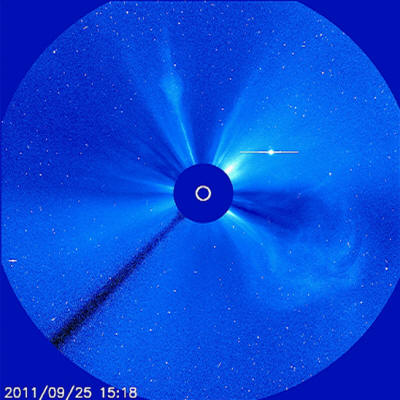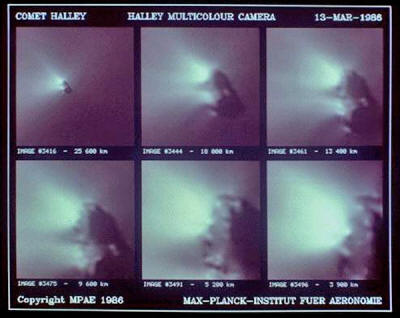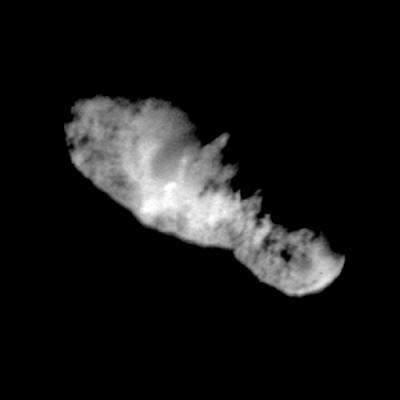|

by Stephen Smith
September 25, 2011
from
Thunderbolts Website

Latest image from the SOHO satellite. No sign of Comet Elenin.
Credit: NASA/ESA
Comet Elenin, despite fear mongers and
media hype, has vanished.
Leonid Elenin discovered C/2010 X1 (subsequently named after him) on
December 10, 2010. The comet reached perihelion on September 11,
2011 but does not seem to have survived its encounter with the Sun’s
electromagnetic fields.
Since the comet’s initial discovery, a litany of doom “prophecies”
has flooded the internet.
According to one report, over 12,000
websites have appeared with warnings of impending disaster or some
kind of world-changing “spiritual” event taking place either at
perihelion (closest approach to the Sun) or on September 23. Both
dates have come and gone, while our globe rolls on without any
effects.
If those who wish to use small comets as their theoretical tools of
destruction were to investigate their structure and behavior,
another way of interpreting what they are would bring an end to such
speculations. The first question to ask is: what is a comet? The
second question is: what effect can they have on Earth?
The commonly accepted view of comets is that they are the remains of
the original nebular cloud out of which our Solar System condensed.
Standard theory states that after the Sun, planets, moons, and planetesimals formed, a vast cloud of frozen water, dust, and gas
known as
the Oort Cloud was left in a halo around the Sun at a
distance of about 50,000 astronomical units (AU). In comparison,
Pluto is approximately 39 AU from the Sun.
An AU is almost 150
million kilometers, or the mean radius of Earth’s orbit.
As the theory goes, matter in the Oort Cloud has also condensed, but
into icy balls rather than rocky bodies. The Merriam-Webster
dictionary definition of a comet is:
“a celestial body that appears
as a fuzzy head usually surrounding a bright nucleus, that has a
usually highly eccentric orbit, that consists primarily of ice and
dust, and that often develops one or more long tails when near the
Sun.”
This conglomeration is often referred to as a “dirty snowball”
in consensus circles.
The
Giotto and
Deep Impact space probes told a different story,
however.
When Giotto made its close approach to Halley’s comet
(below image) in
1986, it sent back images that revealed the comet to be blackened
and scorched.

Indeed,
ESA scientists announced that it was the
blackest object ever discovered, even blacker than the soot-colored
moon
Phoebe.
Other comets have definitively falsified the dirty snowball
hypothesis. When
Shoemaker-Levy 9 exploded after passing near
Jupiter’s magnetosphere,
no volatile compounds were found, leaving
astronomers mystified.
When Deep Space 1, the first spacecraft with
an
ion propulsion drive, flew past comet Borrelly
(below image), the comet
appeared more like an asteroid, possessing a dry, hard surface: no
traces of ice or snowy fields.

Comets experience a steadily increasing voltage and current density
in the solar ‘wind’ as they race toward the Sun. This causes them to
acquire plasma sheaths as they move along, otherwise known as comas.
Some
cometary comas have been estimated to be more than a million
kilometers in diameter.
Eventually, the ‘dark discharge’ mode of the coma switches to the
‘arc mode,’ producing cathode jets and the characteristic comet dust
and ion tails. Close-up images of comet nuclei show bright spots on
the black nucleus, which may be explained as the arc touchdown
locations Unexpected X-rays have been detected coming from the
comet’s plasma sheath.
The energy required to generate X-rays is
supplied by the comet’s electrical discharge.
Comet Hyakutake is a
good example.
Comets are small. Most of them have a nucleus no more than 16
kilometers in diameter. They carry a negative charge with respect to
the Sun, so they begin to discharge violently when they approach the
inner Solar System.
However, their mass is low and their electric
fields are correspondingly weak when compared to Earth.
Mainstream viewpoints must come to realize that asteroids and comets
are not completely different from one another. The
Stardust mission
to
comet Wild 2 gathered samples from its coma, returning material
to Earth that resembled meteoric dust. Not what was expected from a
slushy mudball.
Comets do not initiate earthquakes, tsunamis, or volcanic eruptions
on our planet, especially when they are millions of kilometers away.
If they get close enough to penetrate Earth’s plasmasphere, they
most likely will blow up, just like Shoemaker-Levy 9 did.
|



